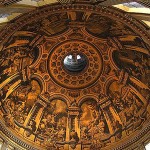Domes, Epitaphs and Lasting Legacies
In 1666, a fire destroyed two-thirds of London, including St. Paul’s Cathedral, which had stood on the same site for more than a thousand years – since 604 AD.
Christopher Wren, an astronomer, mathematician, physicist and founder of the Royal Society, was commissioned to design and rebuild St. Paul’s. Construction on the new Cathedral took thirty-six years, and consumed the entirety of Wren’s architectural career.
Wren was also involved in the design and construction of other churches in London after the Great Fire – completing a total of 55 by the end of his career – but he always viewed St. Paul’s as his crowning architectural achievement. Until his death in 1723 at the age of 91, he was known to visit the cathedral and sit under its dome.
Perhaps he was contemplating his work. Perhaps he was enjoying his achievement. Or perhaps he was contemplating something greater. He once said, after all, that “architecture aims at eternity.”
“Reader, if you seek his monument, look around.”
Today, people can stand in the same spot that Wren used to stand. They can enjoy his spectacular design. They can be inspired by his dome.
And if they look down, on a large brass circular plaque directly beneath the dome, they can read the same words that are also inscribed above Christopher Wren’s tomb in the crypt of the Cathedral.
The words were written by Wren’s son. They read:
“Underneath lies the architect of this church and city, Christopher Wren, who lived upwards of ninety years, not for himself but for the public good.”
And then these last words, which have come to be regarded as one of the world’s most famous epitaphs:
“Reader, if you seek his monument, look around.”
In other words, don’t look here at the floor. Don’t look at this plaque. Don’t look at the tomb where his body lies.
Instead, if you want to see what Christopher Wren did – if you want to see his legacy – look up. Look around. Look at the soaring spaces. Look at the glorious views. Look at the dome which points beyond itself to something greater. Look at this place of worship, which draws our attention to eternity.
Question: Christopher Wren’s legacy happened to be a Cathedral that we can still view today. What will your legacy be? What will the words on your tombstone point people to as your gift to the “public good”? “Reader, if you seek my monument, look . . .” Where?














Hey! Great church blog! Your church is hip and cutting edge! Interesting photo and writing about London’s St. Paul Cathedral!
A hearty hello from Eagan Daily Photo blog
The Cathedral is monumental literally & figuratively. It, like the other European masterpieces (St. Peter’s, Cologne Cathedral, Chartres, & Notre Dame), humbles one to consider the physical, temporal, & monetary sacrifices made for the glory (the very visible glory) of God… It is lamentable that we have less physical masterpieces today, so it must be made up in our spirits and actions…. Well said, Tim.